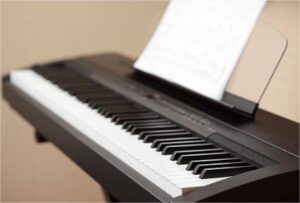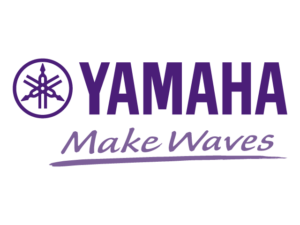Which portable piano should you choose in 2025?
The portable piano is a very popular type of instrument. It’s practical and accessible at every price point, which is why it’s so in-demand.
The problem is, with so many options available, it’s hard to know which one to choose! That’s why in this guide, I’ll go over the advantages of these digital keyboards and, more importantly, recommend some of the most popular models. After reading this guide, you’ll be able to find your ideal portable piano.


What is a portable piano?
Before anything else, it’s important that you fully understand the definition of a portable piano. I’ll then discuss the various advantages and disadvantages of this type of instrument.
Definition

A portable piano is simply a piano that can be transported without a fixed stand. This is therefore the exact opposite of a console digital piano.
To best illustrate this, picture a traditional piano. What do you see? A keyboard, pedals, a stand, legs… In our present case, there will only be a keyboard, and nothing else! Of course, most people buy these digital pianos with a stand and pedal, but what you need to remember is that the piano stand is not attached to the keyboard. Your musical instrument is therefore free as a bird! Woohoo!
Of course, such characteristics will present many strengths, but also some weaknesses.
Pros and Cons
What are the main parameters to remember regarding portable pianos? Here are several that are important to consider.
✅ Key strengths
Easy to transport: The major strength of portable pianos is undoubtedly their ease of transport! You can indeed take them wherever you want. Most even offer battery power allowing you to play anywhere.
Light as air: Okay, I admit, they might be a bit heavier than air. But still, this type of instrument will often be a real featherweight, making transportation even easier.
Discreet and flexible: Its ease of transport makes it very flexible, but also very discreet. It will be much simpler to store than a console version, for example by placing it between two wardrobes, or behind a desk…
Less expensive than console versions: Finally, its last asset, and not the least important, is undoubtedly its price! Indeed, in 95% of cases, a portable digital piano will be cheaper than a console version. Say hello to savings!
❌ Potential drawbacks
Less stability: The first drawback of portable pianos concerns their stability. Some may be delivered with solid stands adapted to the specific model, I’m thinking particularly of the Yamaha P-145, and you’ll have no problems. But for many others, you’ll have to accept inferior stability compared to console versions. A good stand can certainly reduce the problem, but won’t eliminate it entirely.
Less presence: Let’s be honest for a moment… A console piano is still much more beautiful! A portable digital keyboard will indeed be less elegant because only the keyboard element is refined, not the stand that you’ll often buy separately. But we don’t judge on appearance, okay?
Now that you know more about portable pianos, how about choosing yours? Without further ado, let’s discover the different available models!
Which portable digital piano should you choose?
Before choosing your portable piano, you’ll need to pay attention to several elements. Indeed, your decision will depend on your expectations, your level, and your budget. I’ve therefore decided to sort the models below by price range. This will make your information search simpler. Also know that for each portable piano presented, I’ve written a detailed review about it that you can find by clicking on its associated button.
Entry-level portable digital piano
The first three models I’m presenting to you are the Casio CT-S300, Roland Go-61P, and Yamaha Piaggero NP-12. All three will be available at very attractive prices. We’re in entry-level territory. However, these portable pianos remain brand-name models, which gives them rock-solid durability and reliability. All these instruments will have decent touch and sound quality for this price range, even though it won’t compare to high-end models. They also feature battery power allowing you to play wherever you want, with the Yamaha Piaggero NP-12 offering up to 16 hours of battery life!
However, these models will only have 61 keys. While this may be sufficient for a beginner, a more advanced pianist would prefer to go with keyboards having a greater number of keys. But aside from that, these models will be excellent learning tools for beginners.
Mid-range portable digital piano
We’re stepping up a notch by tackling the mid-range portable digital piano category. Here, the features start getting interesting since these models offer us 88 keys. As many as a real acoustic piano! These will benefit from the same advantages as the previous instruments – headphone jack, USB/MIDI connectivity, and battery power – but with the addition of better sound quality and key feel, particularly on the Casio CDP-S110 which is very clearly the best of the three in this area. As for the Roland Go-88P portable digital piano, it includes many more learning solutions like the Skoove and Go Mixer Pro apps, not to mention its Bluetooth functionality.
You’ll have understood that these digital keyboards present stronger arguments that will allow for significantly superior learning and progression. The Casio CDP-S110 will be, in my opinion, the most optimal and complete choice, closely followed by the other two models!
High-end digital standalone piano
Here we are now in the high-end portable digital piano category! Here, you’ll enjoy three models with exceptional sound and touch quality. The Roland FP-30X will be the winner in terms of key feel, which is close to perfection according to all its users. This model also features Bluetooth technology, like the Casio CDP-S360. The Yamaha P-225 will lag a bit behind on this point and won’t have it, but will compensate with exemplary durability that’s beyond question! But that’s not all – these three musical instruments also benefit from the sustain pedal included with delivery, so you won’t need to order one separately. Of course, you can also use piano headphones with these models.
I’d say the winner of this battle is the Roland FP-30X portable digital piano. It will be followed very closely by the Casio CDP-S360 and Yamaha P-225, whose features are more than solid. Know that these will be remarkable instruments that will serve you for many years. They can thus adapt to any pianist of any level. For a motivated beginner, this would therefore be a very smart investment!
Let’s sum up
Ultimately, choosing a portable digital piano will be a significant advantage for many people. These models will be less expensive and more flexible than console versions. In return, you’ll have to accept the fact that they’re often less stable and elegant than more traditional piano versions. Regarding the prices, there really will be something for everyone, so much so that these instruments can suit any level of pianist. So take your time to choose the one that best fits your needs!
I hope this brief guide has helped you find what you came looking for! If not, don’t hesitate to check out my website’s menu which offers numerous solutions. You can also learn about different manufacturers like Yamaha, Roland, or Casio, for example.



